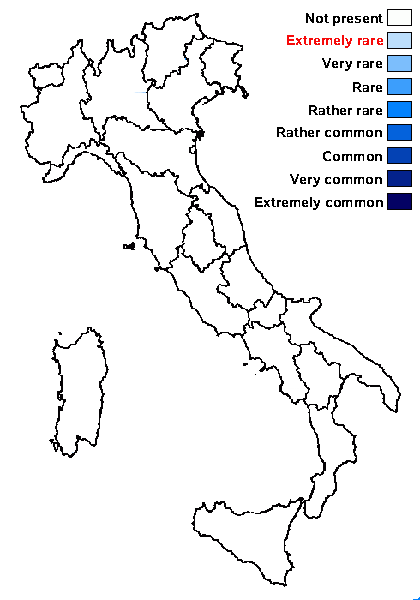Psora cravensis Cl. Roux & Poumarat
Roux & al., Bull. Soc. linn. Provence, 76: 117, 2025.
Synonyms:
Distribution:
Description: Thallus squamulose, the squamules pale pinkish brown, epruinose, 0.5-4.5 mm wide, up to 0.3 mm thick, rounded, adnate in central parts, more or less ascending in peripheral parts, contiguous, with thin, concolorous margins, the upper surface smooth, rarely divided by small fissures, the lower surface pale brown (rarely white), attached by colourless rhizohyphae, without rhizines. Upper cortex overlain by an epinecral layer, colourless or brownish in upper part, 40–75 μm thick, paraplectenchymatous, without crystals; algal layer continuous; medulla white, in upper part, brownish in lower part, rather dense, 65–150 μm thick, inspersed with crystals; lower cortex absent. Apothecia biatorine, sessile, mostly marginal, 0.2-1.5 mm across, usually clustered, with a dark brown to black, finally convex, finely rugose disc and a thin, mostly indistinct and soon excluded proper margin. Proper exciple thin, of anticlinally arranged hyphae resembling paraphyses; epithecium reddish brown, with orange crystals dissolving in K, K+ purple, N-; hymenium colourless, 65–90 μm high, hemiamyloid; paraphyses coherent, simple or sparingly branched, rarely anastomosing, 1.5-2.5 μm thick at mid-level, the apical cell more or less swollen; subhymenium colourless, 60–85 μm high, I-; hypothecium colourless, 170–230 μm high, with crystals of calcium oxalates soluble in N, and insoluble in K. Asci 8-spored, elongate-clavate, with a thin, outer amyloid layer and a thickened tholus penetrated by a tube, the sides of which stain I/KI+ deep blue, without an ocular chamber, Porpidia-type. Ascospores 1-celled, hyaline, ellipsoid, thin-walled, (8-)9.5-13(-14.5) x 4.5-6 µm. Pycnidia rare, immersed in the thallus. Conidia bacilliform, straight, 5.5-9 x 1-1.5 µm Photobiont chlorococcoid. Spot tests: cortex and medulla K-, C-, KC-, P-, UV-. Chemistry: thallus without lichen substances; epithecium with anthraquinones, mainly parietin.Note: a recently-described species growing on soil and terricolous mosses over siliceous, lime-free substrata, mainly in the Mediterranean belt; hitherto known from southern France, to be looked for in Mediterranean Italy. For further details and an extended description see Roux & al. (2025a).
Growth form: Squamulose
Substrata: soil, terricolous mosses, and plant debris
Photobiont: green algae other than Trentepohlia
Reproductive strategy: mainly sexual

Predictive model
Growth form: Squamulose
Substrata: soil, terricolous mosses, and plant debris
Photobiont: green algae other than Trentepohlia
Reproductive strategy: mainly sexual

Predictive model

